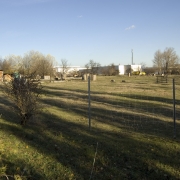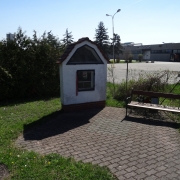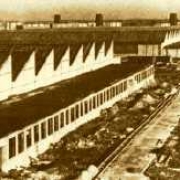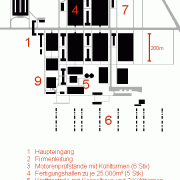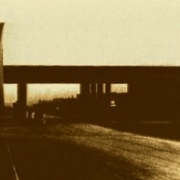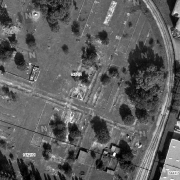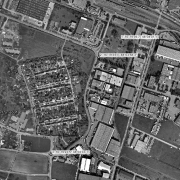Satellite Camp Guntramsdorf / Wiener Neudorf
Establishment of the satellite camp
Wiener Neudorf Subcamp was established on 2 August 1943 on the premises of the labour and forced labour camps of the Flugmotorenwerke Ostmark that had already been set up in 1941. It consisted of 22 living quarters, two infirmary barracks, six lavatories, outhouse barracks, a typist’s office, a kitchen, and a workshop. It was surrounded by barbed wire fence and electric fence, and also guarded with watch towers. The entire camp consisted of 80 wooden barracks (including a foreign and forced labour camp), 34 of which were on the actual camp premises.
Location
The camp covered an area of about two hectares on what is the territory of the town of Guntramsdorf today. The SS camp was located to the north of it. It consisted of a total of six barracks and covered an area of around 14,000 square metres. After a bombing in May 1944, the camp was moved from its original location in Guntramsdorf to the town of Wiener Neudorf further west. Both towns were part of the Groß-Wien urban area during the Nazi era. The so-called “Neue Lager Wiener Dorf” was located to the east of Mödling, in an area called “Mitterfeld”, south of the SCS shopping mall and north of the town centre of Wiener Neudorf. Today, the area of the former “Neues Lager” is fallow land.
Prisoners
On 2 August 1943, the first prisoner transport arrived with 203 prisoners from Mauthausen, who were to build the Wiener Neudorf subcamp. Between 1943 and 1945, up to 3,170 prisoners (highest number was reached in September 1944) from Mauthausen Concentration Camp were assigned to work in the aircraft engine factories, the companies Steyr-Daimler-Puch AG, Rella & Co., Hofman und Maculan, Himmelstoß und Stinner, Ing. Czernilowski, Saurerwerke Zehethofer, and in smaller businesses as well as on farms in the towns of Inzersdorf, Himberg, Schwechat, Guntramsdorf, Laxenburg, Fischamend, and Vienna. The biggest groups of prisoners were from Soviet Union, Poland, and Germany.
Forced labor
Prisoners with experience in metal processing and in construction were particularly requested to be transferred over from Mauthausen. The prisoners were made to work in all areas; during allied air raids, they were even assigned to build a bunker for the factory. In total, the Flugmotorenwerke Ostmark, which was the most expensive armaments project of the entire Nazi era, only produced approx. 3,000 engines. After the war, economists called the Flugmotorenwerke the biggest failed investment of the German wartime economy. It ate up an investment sum amounting to 350,000,000 Reichsmark. As of May 1944, the engine factory was bombed multiple times by the allied forces. The camp, too, located at what is today Industriestraße in Guntramsdorf, was severely damaged during the attacks with a total of 14 bombs. The US bombings, that were directed at the production facilities of the factory, thus claimed 31 lives of prisoners in the camp. The infirmary of the camp also took a direct hit. After that, the Guntramsdorf camp was relocated to Wiener Neudorf.
Guarding
The guards were the 2. company of the SS-Wachsturmbann Mauthausen until early April 1944. SS-Obersturmführer (Senior Assault Leader) Kurt Schmutzler was in command, and SS-Unterscharführer (Junior Squad Leader) Rudolf Lamm was Rapportführer (Report Leader). In April 1944, the 2. company was moved to Ebensee Subcamp. In Guntramsdorf/Wiener Neudorf Subcamp, the guard was taken over by members of the German Air Force, which were incorporated into the SS in December 1944. There was one SS leader, 124 unit leaders, 208 guards (status 27 March 1945), and also 8 to 12 SS dog handlers. The so-called Hundestaffel (dog squad) enjoyed special status at Wiener Neudorf Subcamp: The dogs were used to guard the factory and different work detachments, and they also tracked down prisoners who tried to escape.
Closure
On 2 April 1945, the new subcamp was cleared because of the approaching Russian troops. For the “evacuation”, the prisoners who were still left in the camp had to cover the entire 180 kilometres back to Mauthausen Concentration camp on foot. Right before the “evacuation march” on 2 April 1945, the guards shot those prisoners who were unable to walk and drove the remaining 1,743 prisoners like cattle back to Mauthausen in 13 days. By the time they arrived in Mauthausen, 146 people were “shot on the run” - most of them only because they were unable to keep up any longer due to their poor physical state. Several sources even state that up to 243 people were shot during the death march. On 14 April 1945, those prisoners that survived the death march arrived at Mauthausen Concentration Camp, which was liberated by the American troops on 5 May 1945. Shortly before the end of the war, Daimler-Benz and Steyr-Daimler-Puch transferred most of the machines from Wiener Neudorf to other places, one of them Kirchbichl in Tyrol.
Commemoration and remembrance
In 1995, the Neu-Guntramsdorf parish erected a memorial on the premises of the first camp. The parish has also organised annual memorial services since. The dates can be found in the programme for commemoration and liberation ceremonies [1]. A memorial association [2] was founded in Guntramsdorf in 2005 and has been working on improving and raising public awareness for what little knowledge there is about the little known Guntramsdorf/Wiener Neudorf Subcamp. Thanks to initiative of the association, information boards pointing to the memorial were erected in 2006, and the memorial site itself was refurbished. Moreover, a sculpture and an information board have been put up at the roundabout of Neudorferstraße in 2007. In 2014, the memorial association and contemporary witness and artist Arik Brauer inaugurated a monument and the memorial site near the “Neues Lager Wiener Neudorf”.

